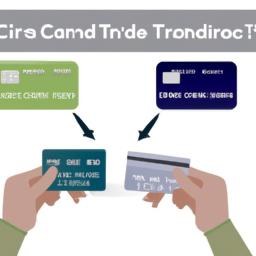How to Do a Balance Transfer on a Credit Card: A Complete Guide

Introduction

Are you struggling to manage your credit card debt? Feeling overwhelmed by high interest rates and multiple payments? It’s time to take control of your financial situation and consider a balance transfer on your credit card. In this comprehensive guide, I will walk you through the step-by-step process of how to do a balance transfer on a credit card, helping you save money and simplify your payments.
Importance of Balance Transfers on Credit Cards
Credit card debt can quickly spiral out of control, making it difficult to keep up with payments and leading to hefty interest charges. This is where balance transfers come in handy. By transferring your existing credit card balance to a new card with a lower interest rate, you can save money on interest and pay off your debt faster.
Benefits of Conducting a Balance Transfer
Conducting a balance transfer offers several key benefits. Firstly, it allows you to consolidate your credit card debt onto one card, simplifying your payments and making it easier to track your progress. Secondly, balance transfers often come with promotional periods that offer low or even 0% interest rates, giving you a window of opportunity to pay off your debt without incurring additional charges. Lastly, a successful balance transfer can potentially improve your credit score by reducing your credit utilization ratio and demonstrating responsible debt management.
Now that we understand the importance and benefits of balance transfers, let’s dive into the details of how to do a balance transfer on a credit card. Stay with me as we navigate through the process step by step, ensuring a smooth and successful balance transfer experience.
Understanding Balance Transfers

Definition of a Balance Transfer
Before we delve into the process of conducting a balance transfer on a credit card, let’s clarify what exactly a balance transfer entails. A balance transfer refers to the action of moving your existing credit card debt from one card to another, typically with the goal of obtaining a lower interest rate. It allows you to transfer the outstanding balance from your current card to a new card, effectively consolidating your debt.
How Balance Transfers Work on Credit Cards
When you initiate a balance transfer, the new credit card company pays off the balance on your old card, effectively assuming your debt. This results in your balance being transferred to the new credit card, typically at a lower interest rate for a specified period. It’s important to note that balance transfers often come with a balance transfer fee, typically a percentage of the transferred amount.
To fully understand the mechanics of a balance transfer, it’s crucial to consider the concept of promotional periods. Many credit card companies offer promotional rates, such as 0% interest for a set period of time, to entice customers to transfer their balances. During this promotional period, you have the opportunity to pay off your transferred balance without incurring any interest charges. However, it’s essential to carefully review the terms and conditions of the new credit card to ensure you understand the duration of the promotional period and any potential fees associated with the transfer.
Factors to Consider Before Conducting a Balance Transfer
Before proceeding with a balance transfer, it’s essential to consider a few key factors. Firstly, assess your creditworthiness and credit score, as these can impact your eligibility for favorable balance transfer offers. Additionally, take note of any outstanding fees, penalties, or rewards on your current credit card, as these may affect your decision to transfer the balance. Lastly, compare the interest rates, balance transfer fees, and terms of various credit card options to find the most suitable option for your specific financial needs.
By understanding the definition of a balance transfer, how it works on credit cards, and the factors to consider beforehand, you are equipped with the necessary knowledge to proceed confidently with your balance transfer journey. Stay tuned as we move forward to the next section, where we will explore the process of choosing the right credit card for balance transfers.
Choosing the Right Credit Card for Balance Transfers

When it comes to conducting a balance transfer on a credit card, selecting the right card is crucial for maximizing your savings and minimizing potential fees. Let’s explore the key factors to consider when choosing the perfect credit card for your balance transfer needs.
Researching Credit Card Options for Balance Transfers
The first step in the process is to conduct thorough research on credit card options specifically designed for balance transfers. Look for credit cards that offer competitive interest rates, promotional periods with low or 0% APR, and favorable terms and conditions. Take your time to compare different cards and find the one that suits your financial goals and needs.
Comparing Interest Rates and Fees
One of the most critical aspects of choosing a credit card for balance transfers is evaluating the interest rates and fees associated with the transfer. Look for cards that offer low or 0% introductory APRs for balance transfers. Keep in mind that these promotional rates are typically for a limited time, so it’s essential to consider the regular APR that will apply after the promotional period ends. Additionally, pay attention to any balance transfer fees, which are usually a percentage of the transferred amount. Factor in these fees when calculating your potential savings.
Assessing Credit Card Terms and Conditions
Before making a decision, carefully review the terms and conditions of the credit card you are considering. Look for any hidden clauses or restrictions that may impact your balance transfer experience. Pay attention to details such as the length of the promotional period, any requirements for maintaining the promotional rate, and any penalties or fees for late payments or exceeding your credit limit. Understanding these terms will help you make an informed decision and avoid any surprises down the line.
By conducting thorough research, comparing interest rates and fees, and assessing credit card terms and conditions, you can choose the right credit card for your balance transfer needs. This careful selection will set the foundation for a successful and cost-effective balance transfer experience.
Step-by-Step Guide: How to Do a Balance Transfer on a Credit Card
Ready to take control of your credit card debt through a balance transfer? Follow these simple steps to successfully navigate the process and achieve financial freedom.
Step 1: Evaluating your current credit card and debt
Before initiating a balance transfer, it’s crucial to assess your current credit card situation. Take a close look at your outstanding balance, interest rate, and any fees associated with your existing card. Understanding these details will help you determine the potential savings and benefits of a balance transfer.
Step 2: Researching credit card options for balance transfers
Next, it’s time to explore credit card options specifically designed for balance transfers. Look for cards that offer low or 0% introductory interest rates for an extended period. Pay attention to any balance transfer fees that may apply and compare the terms and conditions of different cards to find the best fit for your needs.
Step 3: Applying for a new credit card
Once you’ve identified a suitable credit card, it’s time to apply. Fill out the application form accurately and provide all necessary documentation. Keep in mind that approval is subject to the credit card issuer’s criteria, so ensure you meet their requirements.
Step 4: Initiating the balance transfer process
After receiving approval for your new credit card, it’s time to initiate the balance transfer. Contact your new credit card issuer and provide the details of your existing credit card account. They will handle the transfer process, moving your outstanding balance onto the new card.
Step 5: Monitoring the transfer progress
While the balance transfer is in progress, it’s important to stay vigilant and monitor the process closely. Keep an eye on both your old and new credit card accounts to ensure the transfer is completed successfully. Double-check that the balance is correctly transferred and that there are no unexpected fees or issues.
Step 6: Closing your old credit card (optional)
Once the balance transfer is complete and you are satisfied with the new credit card’s terms and benefits, you may consider closing your old credit card account. Closing the account can help streamline your finances and reduce the temptation to accumulate more debt. However, it’s important to weigh the pros and cons before making this decision, as it may impact your credit score.
By following these step-by-step instructions, you can confidently navigate the balance transfer process and take a significant step toward reducing your credit card debt. Remember, always prioritize responsible financial management and make timely payments to maximize the benefits of your balance transfer.
Tips for Successful Balance Transfers
When it comes to conducting a balance transfer on a credit card, there are a few key tips to keep in mind to ensure a successful and smooth process. Let’s explore these tips in detail:
Understanding Promotional Periods and Introductory Rates
One of the primary advantages of balance transfers is the opportunity to take advantage of promotional periods with low or even 0% interest rates. However, it’s crucial to fully understand the terms and duration of these promotional periods. Ask yourself: How long will the introductory rate last? Will the rate apply to both transferred balances and new purchases? By knowing the answers to these questions, you can effectively plan your payments and take full advantage of the interest savings.
Making Timely Payments and Avoiding Late Fees
Timely payments are paramount when conducting a balance transfer. Missing a payment or making a late payment can result in the promotional rate being revoked, potentially subjecting you to higher interest charges. To avoid this, set up automatic payments or mark due dates on your calendar to ensure you never miss a payment. Remember, staying on top of your payments is essential for maintaining a successful balance transfer and maximizing your savings.
Being Mindful of Potential Pitfalls and Risks
While balance transfers offer numerous benefits, it’s important to be aware of potential pitfalls and risks. For instance, some credit cards may charge a balance transfer fee, typically a percentage of the transferred amount. Additionally, if you fail to pay off the transferred balance within the promotional period, you may face high interest rates once the introductory period ends. Carefully read the terms and conditions of your new credit card to understand any potential risks and fees associated with the balance transfer.
By understanding promotional periods, making timely payments, and being mindful of potential risks, you can ensure a successful balance transfer that saves you money and helps you manage your credit card debt effectively. Now, armed with these tips, let’s move forward and continue our journey towards financial freedom.
Continue reading: Conclusion
Conclusion: So above is the How to Do a Balance Transfer on a Credit Card: A Complete Guide article. Hopefully with this article you can help you in life, always follow and read our good articles on the website: kizi5.top



